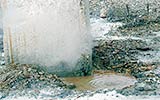Water Pollution
Water quality in the Danube River Basin is largely influenced by the inputs of pollutants caused by human and natural activities - particularly excessive nutrients, organic material, and hazardous substances.
What the ICPDR is doing
The challenge of the ICPDR is to design an effective and manageable emission inventory facilitating monitoring, comparison and improvement of environmental performance for use by decision-makers and the general public.
The public gains awareness and understanding about emissions in their communities and views emission reporting programs as trusted and valuable sources of information.
The availability of information on emission inventory on ICPDR’s web page will provide the public with a tool to communicate with industry and governments.
Emission inventories
Emission inventories (municipal, agriculture and industrial emissions in the Danube River Basin) are databases, which contain basic information on the pollution and supporting data such as the methods used for the measurement, the type of treatment of wastewater, and expected reduction of pollution. Collection of input data needs to be performed in such a way that supports any emission relevant decision. Stringent quality criteria need to be introduced in emission inventories as to specifically assure their accuracy, completeness, consistency and comparability.
Emission inventories 2002
The ICPDR’s Emission Inventory 2002 considers point and diffuse sources of pollution in the whole Danube River Basin. It is not limited to industrial emissions but goes beyond industrial releases and considers environmental emissions from other sources including the agriculture and municipal sector.
Facts and figures
- Municipalities and industry released fewer pollutants in 2002 than in previous years, thanks to the reduced use of polluting production processes, increased investments from governmental and private sources in the water sector, and higher pollution charge rates, which now directly affect the polluters.
- In 2002, reports were submitted by the Austrian authorities for 240 municipal wastewater treatment plants and a similar number of industrial wastewater treatment plants, up from 79 municipal and just 13 industrial plants in 2000.
- Likewise, Romania registered emissions from 116 municipal and 87 industrial wastewater treatment plants in 2002, compared to 52 municipal and 100 industrial plants in 2000.
Did you know?
The owners and operators of all significant point sources of pollution throughout the Danube River Basin are required by the environmental authorities to maintain records and submit detailed reports on emissions and discharges.
Emission inventories – a response to the public’s right to know
In almost all the countries in the Danube River Basin the public have a statutory right to receive information about any polluting emissions in their local communities, and have free access to emission data in national pollutant release and transfer registers, thanks to the recent signing of the legally binding international Kiev Protocol in 2003.
The Kiev Protocol is expected to exert significant pressure towards reductions in pollution, as companies do not want to be identified as being among the biggest polluters.
Other pollution emission registers include the European Pollutant Emission Register (EPER), which was launched in February 2004, and reports on 50 substances emitted to air and water from 56 industrial activities. A more comprehensive version, the European Pollutant Release and Transfer Register (PRTR) will replace EPER and go online in 2009. Its first reporting year will be 2007. The European PRTR will provide information about releases of pollutants The European PRTR will report on more than 91 substances released to air, waterand land from 65 activities, from specific industrial facilities, and by country.
Disclaimer
The information contained in the ICPDR website is intended to enhance public access to information about the ICPDR and the Danube River. The information is correct to the best of the knowledge of the ICPDR Secretariat. If errors are brought to our attention we will try to correct them.
The ICPDR, expert group members, nor other parties involved in preparation of information contained on this website cannot, however, be held responsible for the correctness and validity of the data and information provided, nor accept responsibility or liability for damages or losses arising directly or indirectly from the use of the information conveyed therein.
Only those documents clearly marked ICPDR documents reflect the position of the ICPDR.
Any links to other websites are provided for your convenience only. The ICPDR does not accept any responsibility for the accuracy, availability, or appropriateness to the user's purposes, of any information or services on any other website.
When using the information and material provided on this website, credit should be given to the ICPDR.

